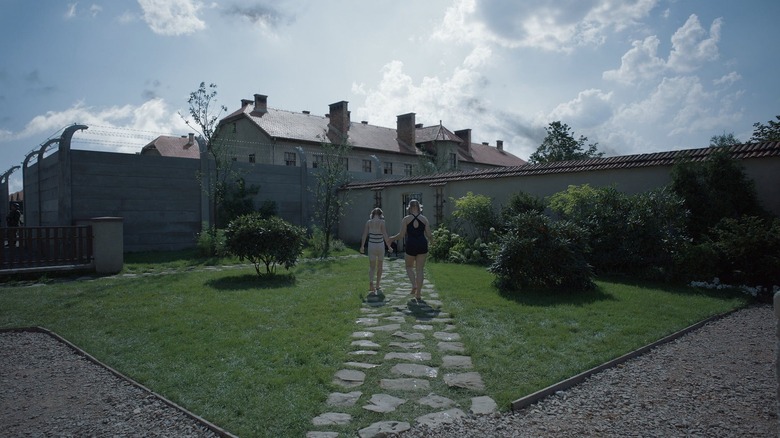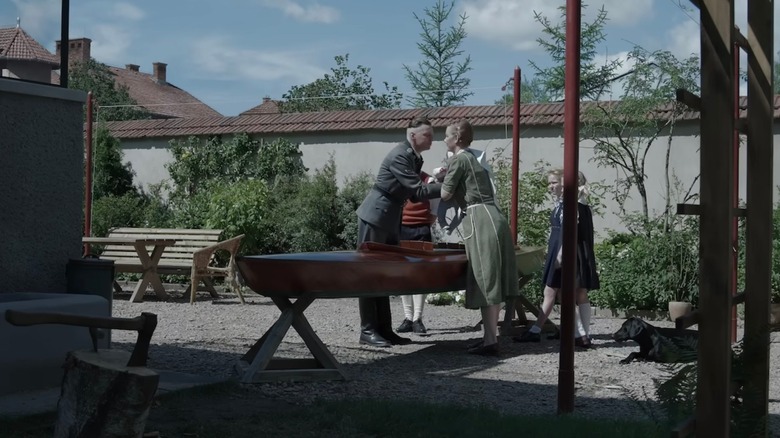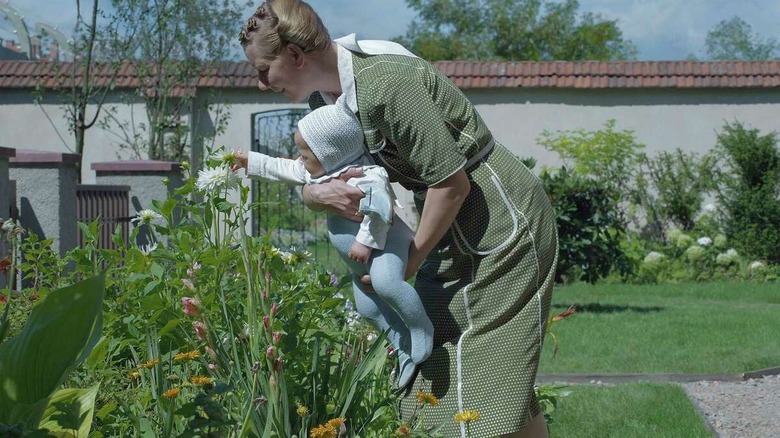The Terrifying Details In The Zone Of Interest Came From Actual Holocaust And WWII Survivors
The horrors of World War II are not depicted on screen in Jonathan Glazer's new film "The Zone of Interest," easily one of the best films of the year. "The Zone of Interest" takes place largely in the posh, well-maintained home of Rudolf Höss (Christian Friedel), which boasts green lawns, a lovely garden, a small pool with a waterslide, and spacious bedrooms. Höss and his family also have a greenhouse and access to a local stream where they swim on sunny days. Höss is also a Nazi commandant in charge of overseeing Auschwitz, a facility that directly neighbors his home. Furnaces, burning up hundreds of human beings, are constantly aflame, and the film's soundtrack booms with the distant fires. Very occasionally, a scream leaks its way in through the Höss family windows.
The Höss family is completely at peace with the death they are complicit in, more concerned with bourgeois comforts and career opportunities than anything human or humane. The film is chilling in its depiction of the banality of evil.
Throughout Glazer's film, there are several color-inverted sequences wherein a young Polish girl sneaks around the walls of Auschwitz, secretly hiding food in the ground or among the prisoners' work equipment, hoping to feed the Nazi's victims. As it so happens, these sequences were based on a very specific real-world experience communicated to Glazer in some research interviews he conducted. In a recent after-film Q&A during nationwide previews for "The Zone of Interest," Glazer talked about that story, and some others that inspired the details of his film.
The Polish girl
The Polish girl is not named, nor is it explained why she felt the need to leave food for the Auschwitz prisoners. It seems that this was a regular action performed by youths who were part of the Polish Resistance. Indeed, one of those Polish Resistance fighters, by coincidence, lived in the home where Glazer shot most of "The Zone of Interest." He told the story:
"The girl in the film is based on a woman I met. A 90-year-old woman who has since passed away, but she lived in that house that we filmed in. Her grandfather built that house. It's about two kilometers from Auschwitz. She basically told me her story, which was that she was a 14-year-old girl at the time, and she joined the Polish resistance. A lot of children did at the time, and their job was [doing] dangerous errands, really – running information back and forth. But for her, it was about leaving food. So that's what she did."
Indeed, not only was the Polish girl based on a real person, but the props and costumes used in the movie were vintage items of hers that she still had in her home, decades later. Glazer continued:
"So the girl you see in the film is based on that [woman], her name is Alexandra. In fact, everything in that house, in that attic, remained and in fact the dress the girl wears was her dress. The bike she rides was her bike. The backpack she uses was her backpack. So it's very realistic to what happened there."
Also in "The Zone of Interest," the Polish girl would find artifacts hidden in the dirt. Pieces of music, for instance, or letters. These were left behind by prisoners in the hope that they would be recovered.
Sunbeams
This, too, was based on the real-life story of Alexandra. Glazer noted that a song was recovered from the dirt in Auschwitz, and, quite mercifully, the composer survived. He ended up recording the song, and it can be heard to this day. Glazer said:
"And the music she finds was – it wasn't a common thing, but there are stories about people who would leave things that are precious to them in the hope that they'd be found at some point. Or letters, and so on. There, of course, were people in those camps who came from all walks of life, and there were composers. And this one gentleman called Joseph Wulf happened to survive the war and record, after the war, the piece of music that he wrote while he was incarcerated. So she finds that in a tin while she's planting pears, and plays it in her apartment in the morning."
The song was called "Sunbeams," and it was written in Yiddish. As one might predict, the song is a somber melody. In "The Zone of Interest," the Polish girl takes it home and plays it. The translated lyrics are: "Sunbeams, radiant and warm. Human bodies, young and old; And who are imprisoned here, Our hearts are yet not cold." The website Forward detailed Joseph Wulf's life, explaining that he was briefly part of the Polish Resistance before being captured in 1943 and sent to Auschwitz — specifically to Buna-Monowitz — for slave labor. After the War, Wulf declared devotion to exposing Nazis who escaped justice and telling the stories of their atrocities. Tragically, he took his own life in 1974.
Wulf's song is the only moment when the victims of Auschwitz have a voice in Glazer's film. The only voices we have are remnants, scattered remains.


